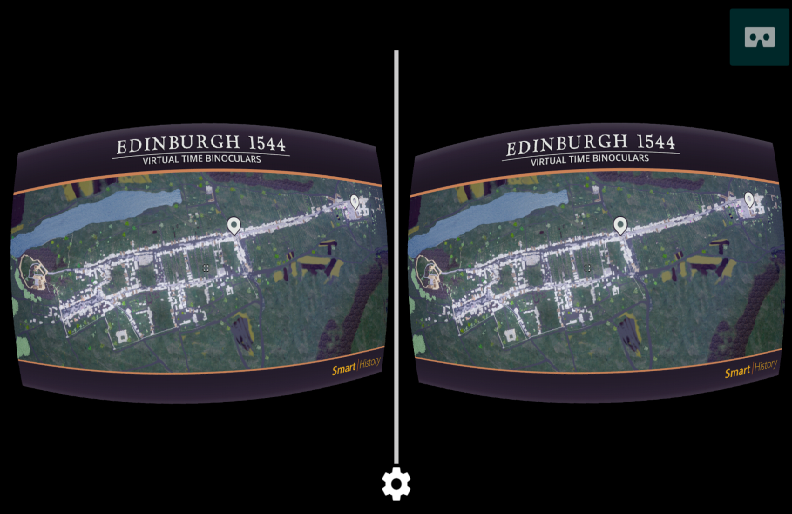For the first time, visitors to Edinburgh will be able to explore the streets, marketplaces and churches as they may have been in the 16th century thanks to academics at the University of St Andrews. The virtual reality app, released this Friday, will add a new dimension for visitors, especially for those visiting the Fringe Festival over the summer.
As well as sweeping panoramas of the city, Edinburgh castle and its surrounding landscape, the mobile app enables exploration of the Netherbow Port, the West Bow, the Grassmarket, Cowgate, Trinity College, Holyrood Palace and St Giles’ Kirk.
“It is striking how the cityscape is both familiar and different from the city today. Instead of the new town there stands a great loch yet the castle stands guard over the city much as it does now,” says Sarah Kennedy, Smart History’s Digital Designer.
Created by the University of St Andrews’s spinout company Smart History, Virtual Time Binoculars: Edinburgh 1544 provides a unique window into the capital around the time of the birth of Mary Queen of Scots. Visitors will experience the digital reconstruction through a virtual reality app that hosts a range of virtual reality headset usage, as well as a web resource.
The Edinburgh reconstructions are just the beginning for Smart History. “We intend for it to be the first of many Virtual Time Binocular apps with depictions of St Andrews and Perth already in the pipeline. We have had interest from across Europe and Latin America, so we expect our Virtual Time travel platform to go global,” says Dr Alan Miller, Director of Smart History.
Read more at:
Volkswagen Uses Virtual Reality to Streamline Vehicle Development
Nokia touts future of virtual reality ads… but who’s the audience?
Google Is Experimenting With Virtual Reality Advertising
On Friday 7 July, Smart History and Museums and Galleries Edinburgh will host a discovery evening at the Museum of Edinburgh where visitors can explore the brand new digital reconstruction of sixteenth-century Edinburgh. Visitors and residents of Edinburgh will for the first time be able to compare the modern city with the capital of James V and Mary Queen of Scots. The new reconstruction is the first to be created of the period, and is based on a drawing from 1544, the oldest relatively realistic depiction of the capital.
At the evening launch attendees will be able to walk through the streets of Edinburgh featuring the entire city held within the video game engine it was built in.
“Ever since we showed the preview video of our digital reconstruction of 1544 Edinburgh, people have been asking when the complete app will be available. We are very pleased to finally release it to the public,” says Dr Elizabeth Rhodes, Smart History’s Historian.
Using their mobile phones and VR headsets, users will become virtual time-travellers as they are immersed in historic scenes, stereoscopic video and 360 degree images. Visitors to the city will explore today’s St Giles’ Kirk and the Grassmarket as they learn more about their 16th century equivalents in parallel.
With the global release of the app on 7 July, Smart History will be in the Scottish capital at the Museum of Edinburgh for city tours and demonstrations from 10am to 4pm both Saturday and Sunday. Expertly guided virtual tours of the Royal Mile will allow virtual time travellers to compare Edinburgh’s past to its present.
“In some ways time binoculars offer better Virtual Time travel than even the Holodeck on the Starship Enterprise. While the holodeck is incredibly realistic, it only exists in one place in time and space. Virtual Time Binoculars is a holodeck you can take anywhere with you,” says Catherine Anne Cassidy, Head of Smart History’s Digital Curation.
The app, which is Google Daydream enabled, allows users to view the reconstructions either in full screen mode or through more immersive virtual reality mode. Hotspots highlight the scenes with more facts and historical images for users to learn about the location.
The digital reconstruction is inspired by a drawing created by the English military engineer Richard Lee, who accompanied the Earl of Hertford’s May 1544 expedition. Lee’s drawing (now held by the British Library) is one of the oldest surviving depictions of Edinburgh, and became the defining English impression of Scotland’s capital.
The interdisciplinary team of St Andrews researchers supplemented the information from Lee’s plan with archaeological evidence, sixteenth-century written sources, and information about the geography of the modern city, to create an updated reconstruction of Edinburgh.
“The Virtual Time Binoculars project is ground breaking for digital reconstruction because it uses technology already in people’s pockets. We have developed a software framework which will enable us to continue to send people back in time,” says Dr Iain Oliver, Head of Systems for Smart History.
More information: Link to app: play.google.com/store/apps/det … ory.edinburgh1544vtb

